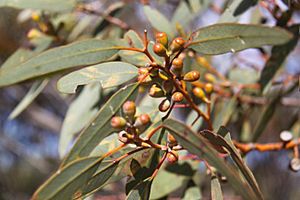Dongara mallee facts for kids
Quick facts for kids Dongara mallee |
|
|---|---|
 |
|
| Flower buds of E. obtusiflora near Arrowsmith | |
| Scientific classification | |
| Genus: |
Eucalyptus
|
| Species: |
obtusiflora
|
| Synonyms | |
|
|
The Eucalyptus obtusiflora, commonly called the Dongara mallee, is a type of mallee tree that grows only in Western Australia. It has smooth, grey or brownish bark that often sheds a bit. Its adult leaves are shaped like a spear or are slightly curved. The tree usually has groups of seven or nine flower buds. These buds open into creamy white flowers. After flowering, it produces cup-shaped, cone-shaped, or barrel-shaped fruits.
What it Looks Like
The Dongara mallee is usually a mallee, which means it's a small, bushy tree with many stems growing from the ground. Sometimes, it can be a small tree. It typically grows to be about 4 to 5 meters (13 to 16 feet) tall. This plant has a special woody swelling at its base called a lignotuber. This helps it regrow after fires.
Its bark is smooth and can be grey or brownish. It often peels off a little on the lower parts of the stems. Young plants and new shoots that grow after the plant has been cut back (called coppice regrowth) have greyish-green leaves. These leaves are egg-shaped and sometimes have a powdery, bluish-white coating, which is called glaucous. They are about 40 to 80 mm (1.6 to 3.1 inches) long and 25 to 40 mm (1.0 to 1.6 inches) wide.
Adult leaves are a dull green, sometimes with a bluish tint, on both sides. They are shaped like a spear or are slightly curved. These leaves are about 70 to 130 mm (2.8 to 5.1 inches) long and 10 to 25 mm (0.4 to 1.0 inches) wide. They narrow down to a stalk called a petiole, which is 12 to 25 mm (0.5 to 1.0 inches) long.
The flower buds grow in the axils of the leaves. An axil is the angle between a leaf and the stem. The buds usually appear in groups of seven or nine. They grow on a single stalk called a peduncle, which is 5 to 20 mm (0.2 to 0.8 inches) long. Each individual bud sits on a smaller stalk called a pedicel, which is 2 to 10 mm (0.08 to 0.4 inches) long.
When the buds are ready to open, they are oval, cylinder-shaped, or spindle-shaped. They are 7 to 12 mm (0.3 to 0.5 inches) long and 5 to 8 mm (0.2 to 0.3 inches) wide. Each bud has a cap called an operculum, which can be rounded or flattened. The Dongara mallee flowers between January and May, producing white or creamy white blooms.
After the flowers, the plant produces a woody fruit. This fruit is a capsule that is cup-shaped, cone-shaped, or barrel-shaped. It is 7 to 12 mm (0.3 to 0.5 inches) long and 7 to 10 mm (0.3 to 0.4 inches) wide. The valves, which are parts that open to release seeds, are almost level with the rim of the fruit.
Name and History
The scientific name Eucalyptus obtusiflora was first officially described in 1828. This was done by a scientist named Augustin Pyramus de Candolle. He wrote about it in his important book, Prodromus Systematis Naturalis Regni Vegetabilis.
The second part of the name, obtusiflora, comes from two Latin words. Obtusus means "obtuse" or "blunt," and -florus means "-flowered." This name refers to the blunt shape of the bud's cap (the operculum). However, this cap is not always blunt on every plant.
For a while, there was some confusion about the name Eucalyptus obtusiflora. The same name was sometimes used for a different eucalyptus species found in New South Wales. This happened because of a mix-up with the original plant samples used to define the species. Now, the eastern Australian species is known by a different name, Eucalyptus obstans, which is also considered a synonym of E. burgessiana. This means scientists have now made it clear which plant is which.
Today, scientists recognize three main types, or subspecies, of Eucalyptus obtusiflora:
- Eucalyptus obtusiflora subsp. cowcowensis
- Eucalyptus obtusiflora subsp. dongarraensis
- Eucalyptus obtusiflora subsp. obtusiflora
Where it Lives
The Dongara mallee grows in Western Australia. You can find it in sandy hollows between sand dunes. Its range stretches from Jurien Bay and Moora in the south, all the way north to Gnaraloo. Inland, it can be found near towns like Wubin, Wyalkatchem, and Corrigin. This plant prefers to grow in sandy-loam soils, which are a mix of sand and clay.

